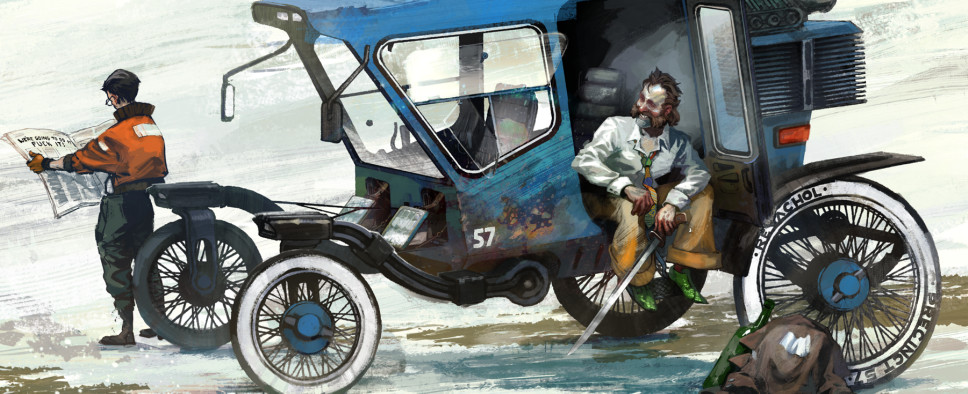No Truce With the Furies Interview
-
Category: News ArchiveHits: 1355

ZA/UM Studio, the team behind No Truce With the Furies, has recently participated in an interview with a Hungarian gaming website Geekz.444. The English version of this interview is available on ZA/UM's developer blog. Enjoy:
A brief summary for those who are not (yet) familiar with No Truce With The Furies. This is an Estonian narrative based isometric rpg with oilpaint-like visuals. The game shares the world of a novel’s titled: Sacred and Terrible Air (Püha ja õudne lõhn) written by Robert Kurvitz who is also a designer of the game. The novel’s genre is fantastic realism. Fantastic realism, according to your devblog means a non-static world. Would you talk a little about this?
KURVITZ: Both the game and the novel take place in a fictional world that we ourselves endearingly call Elysium. This, we dare to say, new type of setting has been dubbed fantastic realism by literary critics. If pressed, I would name three main features that distinguish this world from other sci-fi fantasy settings. These are:
1. It’s non-static as you said. Fantasy settings usually occupy a single period of history, thus forever remaining in a kind of eternal stasis (middle-ages, near-future, cyberpunk, China, you-name-it). Ours has actual six thousand years of history: it spans from its own version of the early Bronze Age (Perikarnassian period) to the early Middle Ages (Franconigerian period), to the Renaissance (Dolorian period), right up to a decade we call “The Seventies”. It’s a world like ours, one that has evolved culturally and technologically over widely varied periods of time. No Truce With the Furies takes place in the modernity of this world.
2. It has geopolitical credibility. In this world there are states, nations, boring political parties, NGOs, and defunct monarchies hanging on to tabloid media to maintain the final threads of relevance. These states, nations, continents all have credible names like Meteo, Vesper-Messina, Revachol, Graad or Vaasa.
3. This world aspires to outmanoeuvre history itself. We don’t only copy the structures and the history of our world, we try to improve upon it. As people who are obsessed with history and who have thus constructed a complete alternative history, we are always looking for ways to out-do the reality. For example, the French and the Russian revolutions are something we are endlessly fascinated with. The Antecentennial (or turn-of-the-century) Revolution is our answer to those historical events. It is an equally grand and even more failed expression of extreme humanism that lays the foundation for the political scene in No Truce With the Furies. Similarly we like to invent new names for familiar things. Motorcarriages instead of cars, anodic music instead of electronic music, pistolettes instead of guns. This should, in effect, bring out the inherent qualities of these daily objects and put them in a fresh light. Elysium, our worldbuilding project, is all about relishing the world, appreciating the world, finding out new and interesting things about the world. It’s for people who have read all of Wikipedia and want more. Another world as believable and terrifying as our own, a tool for analysing ours.
While Dark Souls motto could be something like this: failure is the way to success, according to you failure is fun. In the game one can be silly and can do stupid things. But is this a part of a learning process (like in the Soulsborne games), or the player have to live with the consequences? (Personally I think the latter option means way more fun.)
KURVITZ: Live with the consequences. Failure only leads to more failure.
We want the ultimate failure – your friends giving up on you or you losing your job, the only thing that meant something in your life – to also be a satisfying experience. Story-wise, character-wise. Emotionally not so much. We’ve written out the failure states in this game with much more detail and psychological realism than games usually present failure. You never lose content because of failing, the content just becomes more miserable – and a lot funnier as well. So yes, in that way failure is also fun.
Moreover, it’s quite often a player’s own choice to take needless risks, to recklessly burn the candle from both ends. But you can of course save yourself from failure by dutiful min-maxing. You can be a good power-gaming munchkin. Yes, redemption for this character is possible, but we want it to be hard. There is challenge. A real strategy.
ROSTOV: A lot of video game design revolves around cajoling the player to play through their mistakes. There are lots of things you can do – from superficial stuff like hiding the load button deeper into the menu (bad idea), to adding an ironman checkbox, to actually doing some heavy duty design work on making failures fun. For example, XCOM is legitimately a much more enjoyable game if you don’t reload. And the best session of Civilization is where you’re neck to neck, making mistakes and gaining advantages, but where victory escapes your grasp on the very last second.
In that sense you shouldn’t have to fail, retry and win. Masocore was fun in 2007, but it’s 2017 now, and in No Truce we want you to live with your mistakes.

